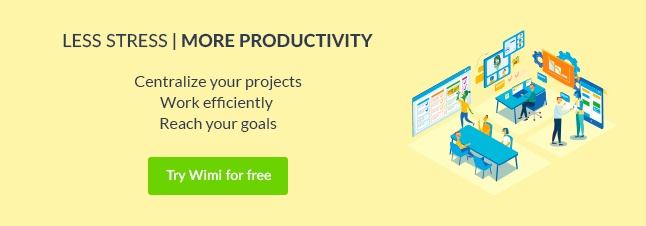You’ve probably already heard of it. Companies are increasingly often choosing to work in project mode. This work method entails numerous advantages. It notably removes organisational barriers by encouraging teamwork in the company and reducing or even eliminating a hierarchy which allows for more flexibility and reactivity.
Could you also see yourself adopting project mode? Follow this guide.
What does ‘working in project mode’ mean?
Working in project mode encourages the collaboration of employees from different professions or different services working on the same project. The focus is on achieving a common goal within a given budget and timeframe, not simply carrying out department specific activities.
It is therefore necessary to unite groups from different or complementary professional backgrounds, competences, qualifications and experiences, to carry out a project from A to Z. They may come from internal departments in the company or from external companies. These people constitute the project’s team.
For support and guidance, they can count on their project leader. Acting more as a leader than manager, the project leader motivates their team to follow a unified vision and objectives. Like an orchestra conductor, they watch over the execution of the project whilst listening to their collaborators, setting an example and not hesitating to delegate responsibility. In short, the team leader is certainly not the stereotypical manager, hidden away in their office, working on undisclosed tasks.
For example, if you have a project to build a house, you need other people:
- An architect, to draw the plans of the house,
- A bricklayer, to build the walls,
- An electrician,
- A plumber,
- A handyman, to fit the windows and doors,
- A carpenter and a roofer for the roof,
- A plasterer,
As the project manager you need to manage, organise and coordinate the teams, the project plan and the different tasks in order to be able to build a solid house whilst also respecting the budget and deadline you have set for yourself.
What are the advantages of this way of working?
This work strategy has become popular due to its numerous advantages:
- Breaking away from the traditional organisational pyramid,
- A better work organisation,
- The decompartmentalization of services,
- A global overview of the projects and a detailed calendar,
- Improved communication and collaboration between different services,
- Improved information sharing,
- Employee empowerment,
- A better distribution of workload,
- The acquisition of new skills,
- The creation of a cohesive team.
5 tips for working in project mode
If you believe that your company should adopt project mode, follow the following 5 steps to implement it.
1) Define a clear vision and precise objectives
To begin with, you should determine the specific details of your project. It is important that the project leader and their team possess all the necessary information to manage the project efficiently.
All the essential data to carry out the project should therefore be centralised in the project brief. Notably you will find:
- The context,
- The issues,
- Objectives,
- Budget,
- Resources and skills needed,
- Project schedule,
- Limitations and potential risks.
This information is invaluable in order for the project to progress smoothly whilst also giving the team an overview of the progress.
2) Establish the roles and responsibilities of each person
In order to carry out your project, you need a qualified team that possesses the necessary skills to accomplish the various tasks.
Clearly define the roles and responsibilities of each team member. Who is in charge of managing the budget? Which team member is keeping an eye on the deadline? Ensure this information is easily accessible for every person involved in the project.
3) Manage changes
The transition to project mode is a big change and it may be difficult to implement. It will certainly result in mixed reactions in your company.
- Complete rejection,
- Enthusiasm,
- Indifference,
Your collaborators may get confused, not knowing who to turn to in case of doubts or questions and some may even refuse to adopt this new way of working.
To ensure this change is accepted, start by identifying which doubts and fears may be hindering your collaborators. Then, provide answers, reassure them and implement solid action plans.
4) Change the company culture
Now that you have successfully convinced your collaborators to work in project mode, you should:
- Teach your team members techniques to work in project mode and project management,
- Define standards for working methods and as well as for your documents
- Empower your team members,
- Encourage communication,
- Encourage creativity, innovation and involvement.
5) Use a collaboration tool
There are numerous tools on the market to help you work effectively in project mode and increase your productivity. The most efficient and comprehensive softwares are without a doubt project management solutions.
Software such as Wimi allows you to centralise your project data, track and manage the progress, have an overview of the tasks, easily organise teamwork and encourage communication between the various people involved in the project. With a tool such as this, working on projects becomes much easier. Test it for free and without obligation and you will see that you will not be able to live without it.
Conclusion
Thanks to project mode, wave goodbye to hierarchy and departmental segregation and instead say hello to teamwork. The advantages of this collaborative way of working are manifold and even if the implementation requires some changes, you will quickly see how effective this is.
Finally, keep in mind that the usage of a project management solution is indispensable to be able to work effectively in project mode.










